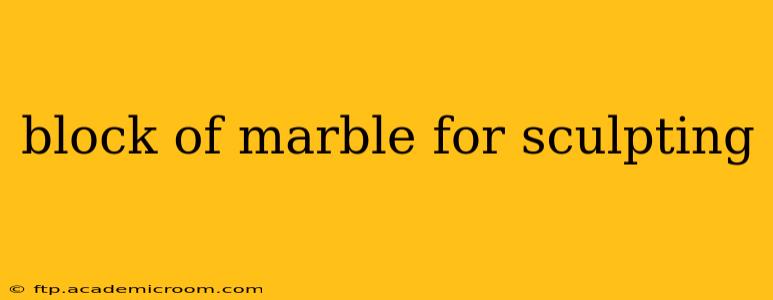Marble, a metamorphic rock prized for its beauty and versatility, has been the medium of choice for sculptors for millennia. From the majestic statues of ancient Greece to contemporary art installations, marble's inherent qualities make it an ideal material for capturing intricate details and expressing artistic vision. However, selecting the right block of marble is crucial for a successful sculpture. This guide delves into the essential considerations when choosing a block of marble for your next project.
What are the different types of marble available for sculpting?
Marble comes in a vast array of colors, patterns, and veining, each with unique characteristics that influence its suitability for sculpting. Some popular choices include:
-
Carrara Marble: Renowned for its pure white color and fine grain, Carrara marble from Italy is a favorite among sculptors for its ability to hold intricate detail. Its smooth, consistent texture allows for precise carving.
-
Statuary Marble: This term generally refers to high-quality marble with a fine grain, suitable for detailed work. While Carrara is a type of statuary marble, other regions produce similar materials.
-
Parian Marble: Known for its bright white color and slightly coarser grain than Carrara, Parian marble from Paros, Greece, was a popular choice in antiquity.
-
Colored Marbles: Many marbles display a range of colors, from soft creams and yellows to deep greens, reds, and blacks. The color and veining can significantly impact the final aesthetic of the sculpture, adding unique visual interest. The sculpting process itself can also reveal hidden color variations within the stone.
How do I choose the right size and shape of marble block?
The size and shape of the marble block are dictated by the scale and complexity of your intended sculpture. Consider these factors:
-
Scale of the sculpture: A larger sculpture naturally requires a larger block of marble. Accurate estimations of the required volume are crucial to avoid wastage and ensure you have sufficient material.
-
Shape of the sculpture: While rectangular blocks are common, you might need a block with a specific shape to minimize waste and optimize the sculpting process. Some sculptors may commission custom-cut blocks to match their design.
-
Weight considerations: Marble is a heavy material. Consider the weight of the finished sculpture and the practicality of handling and transporting it during and after the sculpting process.
What are the key factors to consider when assessing the quality of a marble block?
The quality of a marble block directly impacts the success of the sculpture. Look for these key indicators:
-
Grain size and consistency: A fine, even grain is generally preferred for detailed work, allowing for precise carving and minimizing chipping. Inconsistencies in grain size can make sculpting more challenging.
-
Presence of flaws: Examine the block carefully for cracks, fissures, or other imperfections that could compromise the structural integrity or impede the sculpting process.
-
Color and veining: While personal preference plays a role, consider how the color and veining will contribute to the overall aesthetic of the sculpture.
What is the best way to source a block of marble for sculpting?
Sourcing a suitable block of marble often involves research and direct engagement with suppliers. Consider these options:
-
Marble quarries and suppliers: Directly contacting marble quarries or specialized suppliers offers access to a wider range of materials and potential for custom orders.
-
Online marketplaces: Online platforms may offer a selection of marble blocks, though careful inspection and due diligence are essential to ensure quality.
-
Sculpture supply stores: These stores often carry a selection of marble blocks suitable for various projects and skill levels.
How much does a block of marble for sculpting cost?
The cost of a marble block varies greatly depending on factors like the type of marble, size, quality, and source. High-quality statuary marble, especially from renowned quarries like Carrara, can be quite expensive. Less expensive options exist, but they may compromise on quality or have more pronounced flaws.
How do I prepare a block of marble for sculpting?
Before beginning the sculpting process, the block of marble requires preparation. This often involves:
-
Cleaning the surface: Removing dust and debris from the block ensures a clean working surface.
-
Assessing the block: A thorough examination for flaws is crucial before investing significant time in carving.
-
Creating a preliminary sketch: A well-defined sketch helps to plan the sculpting process and optimize the use of the marble block.
Choosing the right block of marble is a critical step in the sculpting process. Careful consideration of the factors outlined above will help ensure that you select a block that meets your artistic vision and technical requirements. Remember, taking the time to select the perfect material can greatly enhance the final outcome of your masterpiece.
